The Flockeo platform proposes an innovative approach : Travelers become their own guides by choosing sustainable destinations!
Our approach is inspired by the European Commission’s ETIS indicator system , developed to assess the sustainability of tourism destinations. By combining satellite and statistical data, the Flockeo indicator measures the pressure of human activities on the environment. Thanks to an interactive map, users can zoom in on the destinations that interest them and know the index of the region concerned. Through a colors rating, they will be able to easily assess the impact of human activities through four criteria: the ecosystem potential, the risks related to water and the urbanization processes.
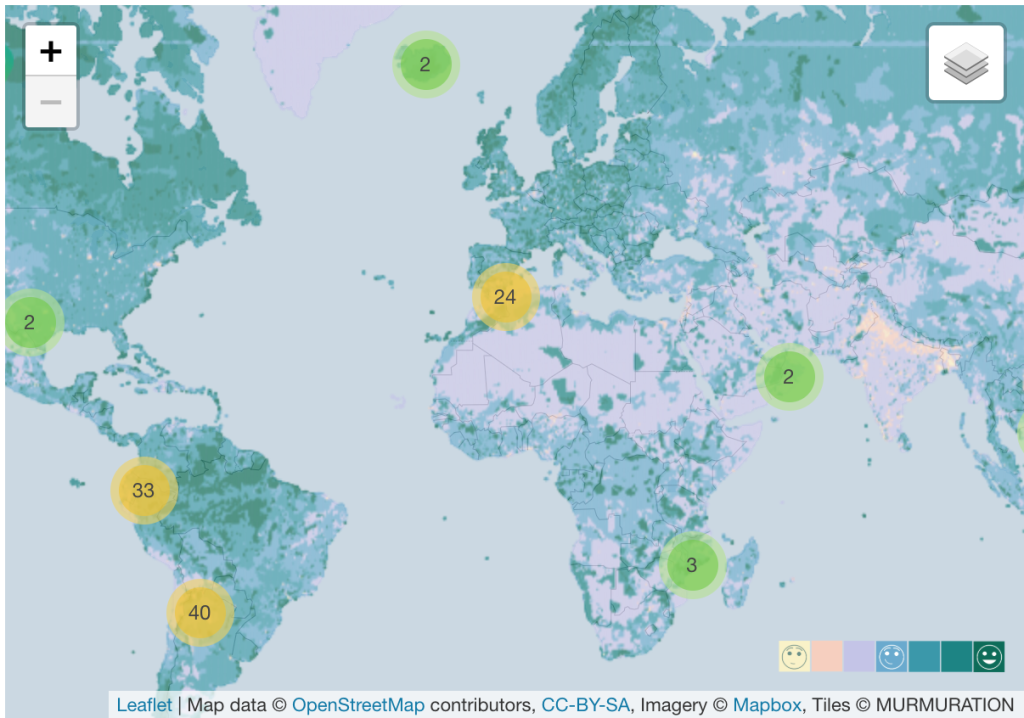
This inclusive approach is possible thanks to satellite data. Combined with various data from local authorities or even the general public (eg tourism statistics), it is possible to envisage large-scale sustainable tourism . The satellite data are factual and invaluable because they allow to go back in time, to identify the problems but also the solutions and to foresee future evolutions.
Through this platform, our desire is to create a global ecosystem that promotes sustainable practices through the linking of all stakeholders in tourism. Whether they are hotels, travel agencies, restaurants, guides, tourist offices, national parks, associations, they need to make themselves known and make their actions visible. These are choices that require significant investment. To highlight them in our platform is our primary mission so that they can devote their time and their budgets to concrete actions.
Sustainable tourism is associated with environmental issues, but not only. It brings together all aspects of sustainable development and also concerns corporate social responsibility. For a travel professional, it’s about maintaining a “spirit of the place” that values the geographical characteristics of a destination through its biodiversity, its cultural wealth, its heritage and the well-being of the inhabitants of the place.
MURMURATION SAS joins ESA BIC Sud France, whose mission is to support the creation of companies and start-ups linked to the space sector. ESA BIC Sud France is one of the 22 incubators of the European Space Agency. Covering the Occitania-Pyrenees / Mediterranean, New Aquitaine, PACA and AuvergneRhône-Alpes regions, ESA BIC Sud France has supported, since its creation in 2013, more than 75 companies.
Space travel is not the only way to bring together “space” and “tourism”. Space can already be a powerful tool in developing appropriate strategies to fight the effects of over-tourism and to assess the environmental impact on tourist destinations.
MURMURATION SAS aims to provide B2B and consulting services for the tourism sector, including a web platform based on earth observation satellite data, Flockeo.
Combining various datasets ranging from public official tourism statistics to proprietary data, it is possible to set up environmental pressure indicators on a global scale. Indeed, the observation of a specific area using satellite data makes it possible to give reliable and transparent measures and actionable data. The satellite data is of great value, as it enables time-travel to the past to assess the situation, provide solutions and to foresee future evolutions.

The term “Murmuration” describes the phenomenon by which starlings gather spontaneously in the sky to face a potential predator.
Faced with the exponential growth of mass tourism and its negative effects on the environment, MURMURATION SAS’s approach is similar: to create an ecosystem of engaged actors in the world of tourism to better measure the environmental pressure on popular destinations and to limit its impacts, in the context of proven climate disruption. It’s all about creating the conditions for the development of sustainable and reasoned tourism!
Study the environmental impact of tourist sites,
Raise the community’s awareness to sustainable tourism
Enhance the community commitment to social and environmental actions
Copyright image ImaginEarth
MURMURATION SAS is currently working on the FLOCKEO web platform to offer travelers and travel professionals a map of the world to know the environmental impact on destinations.

The FLOCKEO barometer uses 3 essential indicators that combined satellite data with other data to evaluate the ecological footprint on tourist destinations.
The International Union for the Conservation of Nature (IUCN) is one of the world’s leading organizations dedicated to the protection and preservation of nature. The FLOCKEO barometer takes into account data from protection programs at international, national and / or regional level and also the quality controls to ensure their effectiveness.
Satellite data combined with other data sources can be used to estimate the risks related to water. The FLOCKEO barometer takes into account the quantity, the quality, as well as the existence and the relevance of the infrastructures for a better management of water around the world.
The indicator makes it possible to specify low density areas as well as very dense urban areas by combining several data, including satellite data. The FLOCKEO barometer thus guides travelers to more or less dense urban areas and creates their own “green” journey.
D-3 before the official release of the FLOCKEO website
Global warming, pollution, degradation of cultural sites, deforestation … the effects of overtourism on the environment and populations can be dramatic.
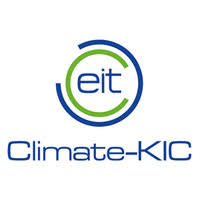
MURMURATION is one of the start-ups that has joined the acceleration program of Climate-Kic France . This program is intended for all start-up companies that are motivated and committed to solving the problems related to climate change. Thanks to Flockeo, we want to implement an inclusive approach!
Over-tourism, over-crowding of sites and the under-frequenting of other sites which, however, have put in place the necessary infrastructures are critical for travel professionals who see their “working tool” deteriorate or, conversely, little known. MURMURATION has developed a solution that combines environmental studies and a web platform, Flockeo, in order to provide reliable indicators to manage a tourist destination, to make it known and to make visible the daily work of the traveling professionals who commit themselves.
Some places are not suitable to receive too many travelers. In Venice, for example every year millions of visitors for some tens of thousands of Venetians who live there. Unesco has also listed the city on the list of World Heritage in Danger. This was also the case for the city of Dubrovznik in Croatia last summer.
For example, the need for water to fill pools in hotels and fossil fuels, for example to cool in countries where resources are very limited, can create major problems. The countries of the Mediterranean are the most exposed because most of them favor mass tourism without implementing the necessary infrastructures.
The most infamous example is the Maya Bay beach from the movie “The Beach” with Leonardo Di Caprio. This beach was closed by the Thai authorities until 2021 to allow the coral reefs to reform and thus prevent the erosion of the bay. The damage to the natural ecosystem of this bay is such that the beach had to be closed to motorboats and tourists.
The growth of tourism by 2050 will double energy consumption and greenhouse gas emissions. The carbon footprint of tourism is generated by transport but also by the need to produce all that tourists need on their vacation spot. The two tourist cities, Jakarta and Denpasar, in Bali are among the most polluted cities in the world.
Climate change affects all regions of the world. Polar ice caps are melting and ocean levels are rising. In some regions, extreme weather events and precipitation are becoming more frequent, while others are facing increasingly extreme heat waves and droughts. Floods are the most expensive natural disasters in the world. The cost of flood damage amounts to billions of euros. Also, the human losses are dramatic.
#1 Sierra Leone : more than 500 dead and 810 missing as a result of a landslide caused in 2017 by intense rains.
#2 United States : 42 victims after hurricane Harvey and 30,000 displaced people.
#3 Niger: 44 victims during the monsoons of 2017 and more than 70,000 victims.
#4 China: The 2017 floods were responsible for 228 deaths and 3.5 million displaced people across the country.
#5 Sri Lanka : 300 deaths from a dengue epidemic, whose floods have spurred proliferation.
#6 Central Africa : Persistent drought, consecutive cyclones and floods have completely devastated crops in this region, which is highly dependent on rainfed agriculture and smallholder farmers. Nine countries in the region will be most affected by the climate crisis in the coming years: Malawi, Mozambique, the Democratic Republic of Congo (DRC), Tanzania, Zambia and Zimbabwe.
#7 Floods in Venice : For the past few days, St. Mark’s Basilica has been weakened by a historic high tide! Water has flooded the cafe terraces and has even flooded the hotels. the tourists had to return to their hotels, sometimes even passing through the windows.
Satellite images are a powerful tool for Earth observation and monitoring sensitive areas. As part of the Copernicus program and mandated by the European Commission, ESA (European Space Agency) has implemented the Sentinel satellites, the guards of the planet. Thanks to this program, we could detect hydrocarbon pollution at large of the Brazilian coasts and provide evidence for local authorities to help uncover the origin of this major disaster.
At MURMURATION, we confirm the catastrophic situation that these Brazilian coasts are currently experiencing. As shown in the following Sentinel images, we are able to detect oil pollution off the Brazilian coasts in the east, in the state of Bahia.
Oil slicks are observed spanning over 20km, which corresponds to 800 Tennis courts!
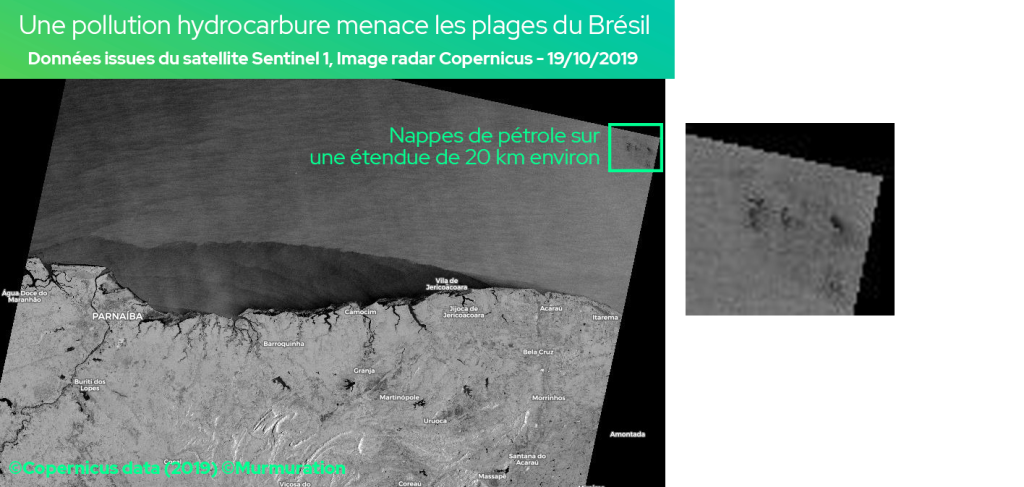
The Sentinel 1 radar images of the Copernicus program provide all-weather imagery (passing through cloud cover) thus enabling the handling of emergency situations (natural or industrial disasters) and environmental monitoring (sea ice, glaciers, water extents, landslide, and so on).
An extent of about 10 km of oil slicks was observed off Açu de Torre … which corresponds to nearly 400 tennis courts!
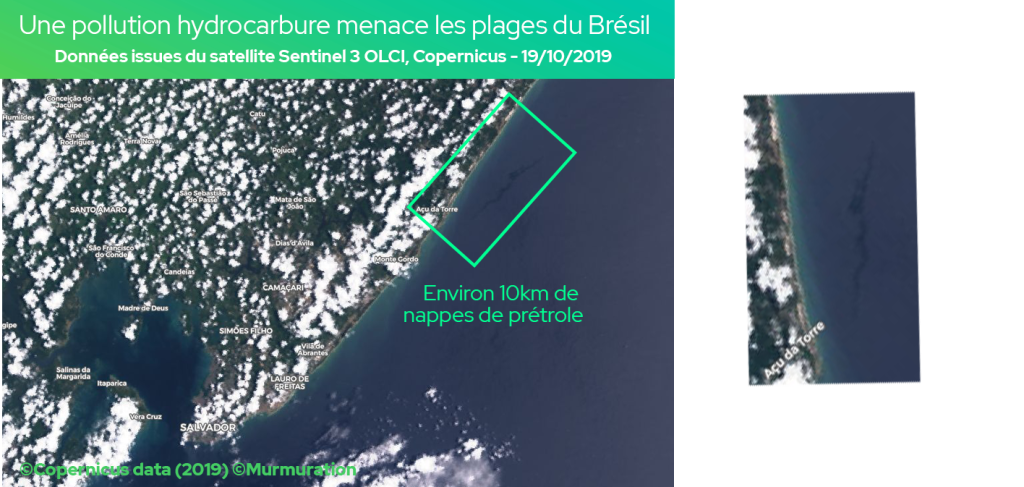
Sentinel 3 OLCI satellite images (Ocean and Land Color Instrument) allow measuring the state of the oceans and coastal zones (pollution, current …) thanks to color levels (spectral bands).
The Brazilian oil spill is an unprecedented ecological disaster with a short, medium and long-term impacts on the natural ecosystems and the economy of the country. Marine ecosystems are becoming stagnant while the country’s economy can be affected. Brazilian beaches, reputed for their beauty and attracting tourists from all over the world, may be deserted by travelers. The tourism sector is already heavily impacted by the situation ! But the worst is yet to come : Cleaning is almost impossible under current conditions.
O óleo no Nordeste e a destruição da Amazônia mostram as consequências do desmonte ambiental promovido pelo governo, prejudicando a imagem do país. Os impactos são gravíssimos para os oceanos, a Amazônia e a vida das pessoas. https://t.co/1PR9Rh6a1B #InimigoDoMeioAmbiente pic.twitter.com/sfZd2MxEla
— Greenpeace Brasil (@GreenpeaceBR) October 23, 2019
While the Global Climate Strike has begun these days around the world, we are looking at MURMURATION SAS for the growing impact of two crucial and social issues in terms of overtourism – which can be found through the case study from BALI.
Overtourism has become a crucial issue for the tourism sector. Moreover,, the effects of climate change have major issues, caused by humans and that directly affect our daily lives and the future.
We propose to counter the challenge of overtourism through the use of satellite data. Take the example of Indonesia: How a study on environmental impact could help to change the tourism sector in Bali
Bali is an Indonesian island famous for its wooded volcanic mountains, rice paddies, beaches and coral reefs. Unfortunately, it suffers from overtourism especially south of the island. Buildings are accelerating at the expense of nature and local life. and the lively tourist coasts do not benefit as much as locals in terms of economic development. the lively tourist coasts do not benefit as much as the locals in terms of economic development.

The map above gives some pointers to favor sustainable tourism, a true vector of love and peace between cultures.
The small town of Munduk offers to explore the inner region of Bali. The inhabitants of Munduk are less accustomed to crossing tourists but he remains very enthusiastic to meet and exchange with foreigners. The nature around Munduk allows beautiful breakaways. Many hiking trails start from Munduk and the surrounding hills soon become accessible. There are great walks in the forest with beautiful waterfalls and breathtaking views of rice terraces to the west of the city. Small Indonesian restaurants called “warung”, very simple and cheap, allow Indonesians and tourists to enjoy the local gastronomy. The traveler becomes an active player in his journey by choosing to go where his presence will be a source of meetings and sharing. The map above would avoid the mistakes made in the past and propose a sustainable tourism management taking into account the water needs, the establishment of the infrastructures necessary for the accommodation, and also the management of waste and transport for the benefit of local residents as well.
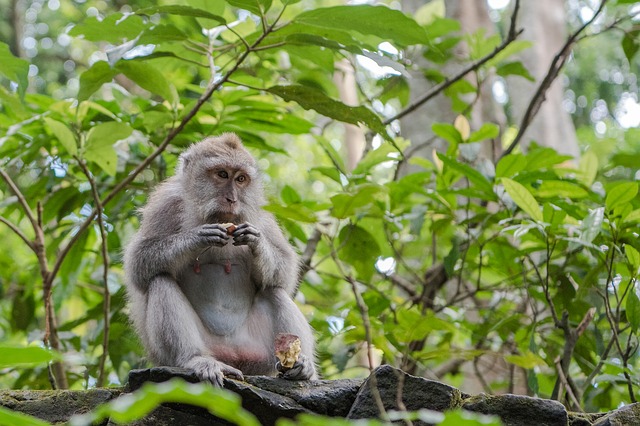
Indonesia is the third tropical forest in the world, even more threatened than the Amazon and regularly ravaged by the flames. Every minute is an area equivalent to six football pitches that is deforested according to the magazine Geo. The West Bali National Park is an example of preservation: 160 species of birds have been listed in the park, including the virtually extinct Bali Starling (Leucopsar rothschildi), the only endemic vertebrate species in Bali, the icon of wildlife. Bali. This is the main reason why this national park was created in 1941. In 2001, it was estimated that only six starlings would have survived in the wild, all in this park. Since then, captive breeding and reintroduction efforts have continued at a steady pace, but poaching pressures remain a major problem. With this in mind, a second reintroduction program was launched in the remote areas of Nusa Penida off Sanur Beach in 2004.

Tomorrow, millions of people around the world will leave their jobs or homes to join the global climate strike on the streets and demand the end of the fossil fuel era.
The tourism sector is undergoing a major digital transformation. The web and social media have fundamentally changed the way companies do business and the way people connect with each other. It is not only a technological evolution but a social transition that operates through the web technologies. Traveling is one of the activities that we do in order to change our relationship to the world and discovering new perspectives. It is also one of the most important economic sectors : tourism represents 10% of world GDP.
Users who create their own travel content are now the primary reference sources for travel information. Nearly 2.4 billion people use a smartphone in 2017, an increase of 10.8%.
1/3 of the world’s population has adopted mobile phone use which has significantly increased the amount and type of user-generated content, including in the tourism sector.
Many social media channels have been launched during the past decade, Instagram, Pinterest, SinaWeibo and Snapchat to name a few. These platforms have implemented features that allow users to include the name and geographic coordinates of their locations and the trips they make.
A major turning point in the sharing of experience, it is now in real time and can have immediate consequences on tourist destinations. 22% of travelers use the contents of their relatives to choose their future destination.
According to “Think with Google”, 85% of travelers decide activities only after arriving at their destination. The democratization of the media has lowered costs and technical barriers in marketing and communication. This offers new opportunities for low-income countries or smaller players in tourism. They can develop their presence on the web, use new data sources and communicate directly with travelers
All these figures lead us to ask the following question: what tourism do we want for tomorrow?
Tourism accounts for more than 10% of global GDP and 7% of all international trade activity. With $6.1 billion in revenue, tourism is the world’s third largest exporter, ranks after chemicals and fuels and ahead of automotive products.
Moreover, tourism is a local development aid when it leads to improvements in terms of infrastructure, such as transport (airports, roads, rail networks), land use planning for drinking water and sanitation, energy consumption, medical services, mobile phone networks and security that are appreciated by tourists and locals alike.
Inclusive growth in the tourism sector affects other sectors. Indeed, tourism depends on a large supply chain, which includes transport providers, interpreters, accommodation, agricultural producers, catering, energy, water supply, preservation of heritage. cultural, arts and crafts, construction and maintenance of buildings, preservation of biodiversity and wildlife. Thanks to this inclusive approach, tourism can benefit a large number of people.
In addition, there is a big issue for both urban and rural populations. By 2050, the urban population will increase to 66 percent, or six billion people, with concentrated growth in Asia and Africa. Many cities will continue to base their economic growth on tourism and its potential for job creation and infrastructure improvement. Rural communities attract investment to promote rural areas and also to attract the profits of tourism.
Ecotourism is growing strongly. Not only does it increase the conservation value of Nature, but it also helps to generate funds useful for its conservation. A survey conducted by UNWTO found that wildlife tourism accounts for 80% of total annual travel sales in Africa, and this share is growing. The economic impact of nature and wildlife activities motivates local people to play an active role in conserving biodiversity and preventing poaching.
Policies supporting ecotourism, or green tourism, make it possible to receive financial contributions for the preservation of biodiversity, water reservoirs and to help reduce CO2 emissions. Finally, tourism is often an innovative sector in terms of sustainable consumption and awareness of climate change. There are many examples of tourist resorts introducing wind and solar energy, organic farming and sustainable fishing.
Cultural tourism is an important segment of tourism, and visitor spending on tickets, guides and souvenirs contributes to the capital needed to protect important sites. The UNWTO “Silk Road” program, which includes 33 states, is a remarkable example.
Intangible cultural heritage, through music, performing arts and oral traditions can also be revitalized or protected by tourism. The local communities organize cultural excursions whose purpose is to share cultural diversity, an invaluable wealth for travelers who are aware of it.
Tourism can be an effective way of involving visitors in philanthropy. Social and solidarity tourism allows visitors to participate in local lives, to understand local cultures and to show empathy. For journeys also make it possible to encourage the creation of family bonds, reflections on oneself, on Life and Love.
Tourism can serve as a tool to recover from a major conflict. Rwanda is one of the most striking examples. Rwanda becomes one of the world’s destinations based on ecotourism. The priority given by the Rwandan government to sustainable development is bearing fruit. The development of sustainable tourism has not only brought new inclusive employment patterns, it supports growth and improved infrastructure in the country, and thus contributes to post-conflict stabilization.
To know more : – The World Bank study 20 Reasons Sustainable Tourism Counts for Development – UNWTO “Silk Road” program – New York Times Nyungwe forest is a magnificent place for ecotourism